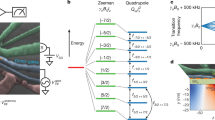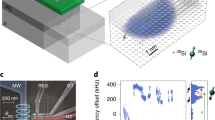Abstract
The analytical technique of nuclear magnetic resonance (NMR1,2) is based on coherent quantum mechanical superposition of nuclear spin states. Recently, NMR has received considerable renewed interest in the context of quantum computation and information processing3,4,5,6,7,8,9,10,11, which require controlled coherent qubit operations. However, standard NMR is not suitable for the implementation of realistic scalable devices, which would require all-electrical control and the means to detect microscopic quantities of coherent nuclear spins. Here we present a self-contained NMR semiconductor device that can control nuclear spins in a nanometre-scale region. Our approach enables the direct detection of (otherwise invisible) multiple quantum coherences between levels separated by more than one quantum of spin angular momentum. This microscopic high sensitivity NMR technique is especially suitable for probing materials whose nuclei contain multiple spin levels, and may form the basis of a versatile multiple qubit device.
This is a preview of subscription content, access via your institution
Access options
Subscribe to this journal
Receive 51 print issues and online access
$199.00 per year
only $3.90 per issue
Buy this article
- Purchase on Springer Link
- Instant access to full article PDF
Prices may be subject to local taxes which are calculated during checkout




Similar content being viewed by others
References
Ernst, R. R., Bodenhausen, G. & Wokaun, A. Principles of Nuclear Magnetic Resonance in One and Two Dimensions (Oxford Univ. Press, Oxford, 1987)
Liang, Z. P. & Lauterbur, P. C. Principles of Magnetic Resonance Imaging: A Signal Processing Perspective (IEEE Press, Piscataway, 1999)
DiVincenzo, D. P. Quantum computation. Science 270, 255–261 (1995)
Chuang, I. L., Vandersypen, L. M. K., Zhou, X., Leung, D. W. & Lloyd, S. Experimental realization of a quantum algorithm. Nature 393, 143–146 (1998)
Kane, B. E. A silicon-based nuclear spin quantum computer. Nature 393, 133–137 (1998)
Nakamura, Y., Pashkin, Yu. A. & Tsai, J. S. Coherent control of macroscopic quantum states in a single-Cooper-pair box. Nature 398, 786–788 (1999)
Mooij, J. E. et al. Josephson persistent-current qubit. Science 285, 1036–1039 (1999)
Vandersypen, L. M. K. et al. Experimental realization of Shor's quantum factoring algorithm using nuclear magnetic resonance. Nature 414, 883–887 (2001)
Leuenberger, M. N. & Loss, D. Quantum computing in molecular magnets. Nature 410, 789–793 (2001)
Leuenberger, M. N., Loss, D., Poggio, M. & Awschalom, D. D. Quantum information processing with large nuclear spins in GaAs semiconductors. Phys. Rev. Lett. 89, 207601 (2002)
Taylor, J. M., Marcus, C. M. & Lukin, M. D. Long-lived memory for mesoscopic quantum bits. Phys. Rev. Lett. 90, 206803 (2003)
Levitt, M. H. Spin Dynamics (Wiley, New York, 2002)
Wald, K. R., Kouwenhoven, L. P., McEuen, P. L., van der Vaart, N. C. & Foxon, C. T. Local dynamic nuclear polarization using quantum point contacts. Phys. Rev. Lett. 73, 1011–1014 (1994)
Gammon, D. et al. Nuclear spectroscopy in single quantum dots: nanoscopic Raman scattering and nuclear magnetic resonance. Science 277, 85–88 (1997)
Kikkwawa, J. M. & Awschalom, D. D. All-optical magnetic resonance in semiconductors. Science 287, 473–476 (2000)
Machida, T., Yamazaki, T., Ikushima, K. & Komiyama, S. Coherent control of nuclear-spin system in a quantum Hall device. Appl. Phys. Lett. 82, 409–411 (2003)
Yusa, G., Hashimoto, K., Muraki, K., Saku, T. & Hirayama, Y. Self-sustaining resistance oscillations: Electron-nuclear spin coupling in mesoscopic quantum Hall devices. Phys. Rev. B 69, 161–302 (2004)
Salis, G., Awschalom, D. D., Ohno, Y. & Ohno, H. Origin of enhanced dynamic nuclear polarization and all-optical nuclear magnetic resonance in GaAs quantum wells. Phys. Rev. B 64, 195304 (2001)
Eickhoff, M., Lenzman, B., Flinn, G. & Suter, D. Coupling mechanisms for optically induced NMR in GaAs quantum wells. Phys. Rev. B 65, 125301 (2002)
Nielsen, M. A. & Chuang, I. L. Quantum Computation and Quantum Information (Cambridge Univ. Press, Cambridge, 2003)
Cohen-Tannoudji, C., Dupont-Roc, J. & Grynberg, G. Atom-photon Interactions: Basic Processes and Applications 488–489 (Wiley, New York, 1998)
Wokaun, A. & Ernst, R. R. Selective excitation and detection in multilevel spin systems: Application of single transition operators. J. Chem. Phys. 67, 1752–1758 (1977)
Leuenberger, M. N. & Loss, D. Grover algorithm for large nuclear spins in semiconductors. Phys. Rev. B 68, 165317 (2003)
Ahn, J., Weinacht, T. C. & Bucksbaum, P. H. Information storage and retrieval through quantum phase. Science 287, 463–465 (2000)
Grover, L. K. Quantum computers can search arbitrarily large databases by a single query. Phys. Rev. Lett. 79, 4709–4712 (1997)
Kronmüller, S. et al. New resistance maxima in the fractional quantum Hall effect regime. Phys. Rev. Lett. 81, 2526–2529 (1998)
Hashimoto, K., Muraki, K., Saku, T. & Hirayama, Y. Electrically controlled nuclear spin polarization and relaxation by quantum-Hall states. Phys. Rev. Lett. 88, 176601 (2002)
Smet, J. H. et al. Gate-voltage control of spin interactions between electrons and nuclei in a semiconductor. Nature 415, 281–286 (2002)
Acknowledgements
The authors are grateful to T. Fujisawa, Y. Tokura, S. Sasaki, K. Semba, S. Saito, K. Ono, S. Tarucha, T. Machida, T. Ota and N. Kumada for discussions.
Author information
Authors and Affiliations
Corresponding authors
Ethics declarations
Competing interests
The authors declare that they have no competing financial interests.
Rights and permissions
About this article
Cite this article
Yusa, G., Muraki, K., Takashina, K. et al. Controlled multiple quantum coherences of nuclear spins in a nanometre-scale device. Nature 434, 1001–1005 (2005). https://doi.org/10.1038/nature03456
Received:
Accepted:
Issue Date:
DOI: https://doi.org/10.1038/nature03456
This article is cited by
-
NMR Hamiltonian as an effective Hamiltonian to generate Schrödinger’s cat states
Quantum Information Processing (2022)
-
Solid-state NMR spectroscopy
Nature Reviews Methods Primers (2021)
-
Nuclear spin quantum register in an optically active semiconductor quantum dot
Nature Nanotechnology (2020)
-
Room Temperature Electrically Detected Nuclear Spin Coherence of NV Centres in Diamond
Scientific Reports (2020)
-
Dynamical coupling between a nuclear spin ensemble and electromechanical phonons
Nature Communications (2018)
Comments
By submitting a comment you agree to abide by our Terms and Community Guidelines. If you find something abusive or that does not comply with our terms or guidelines please flag it as inappropriate.



